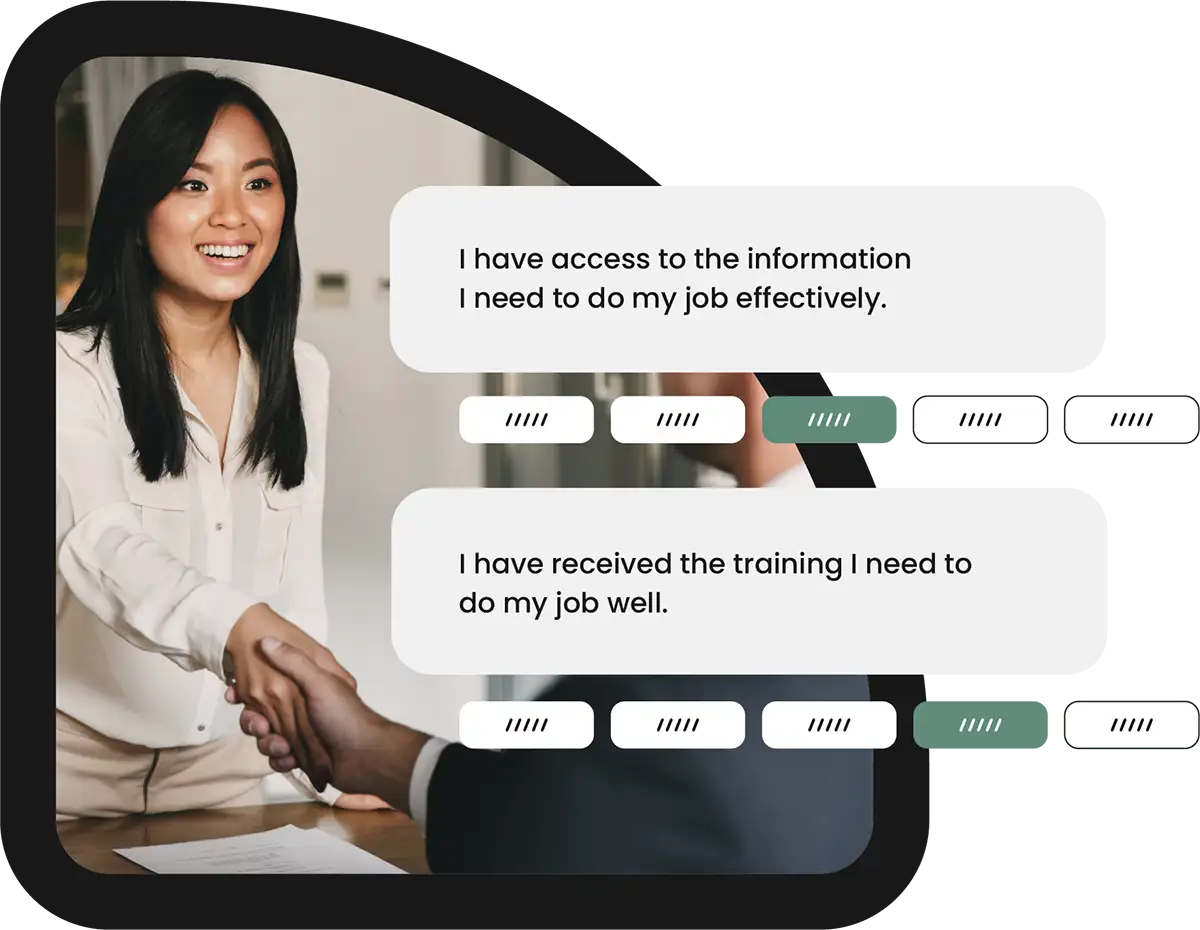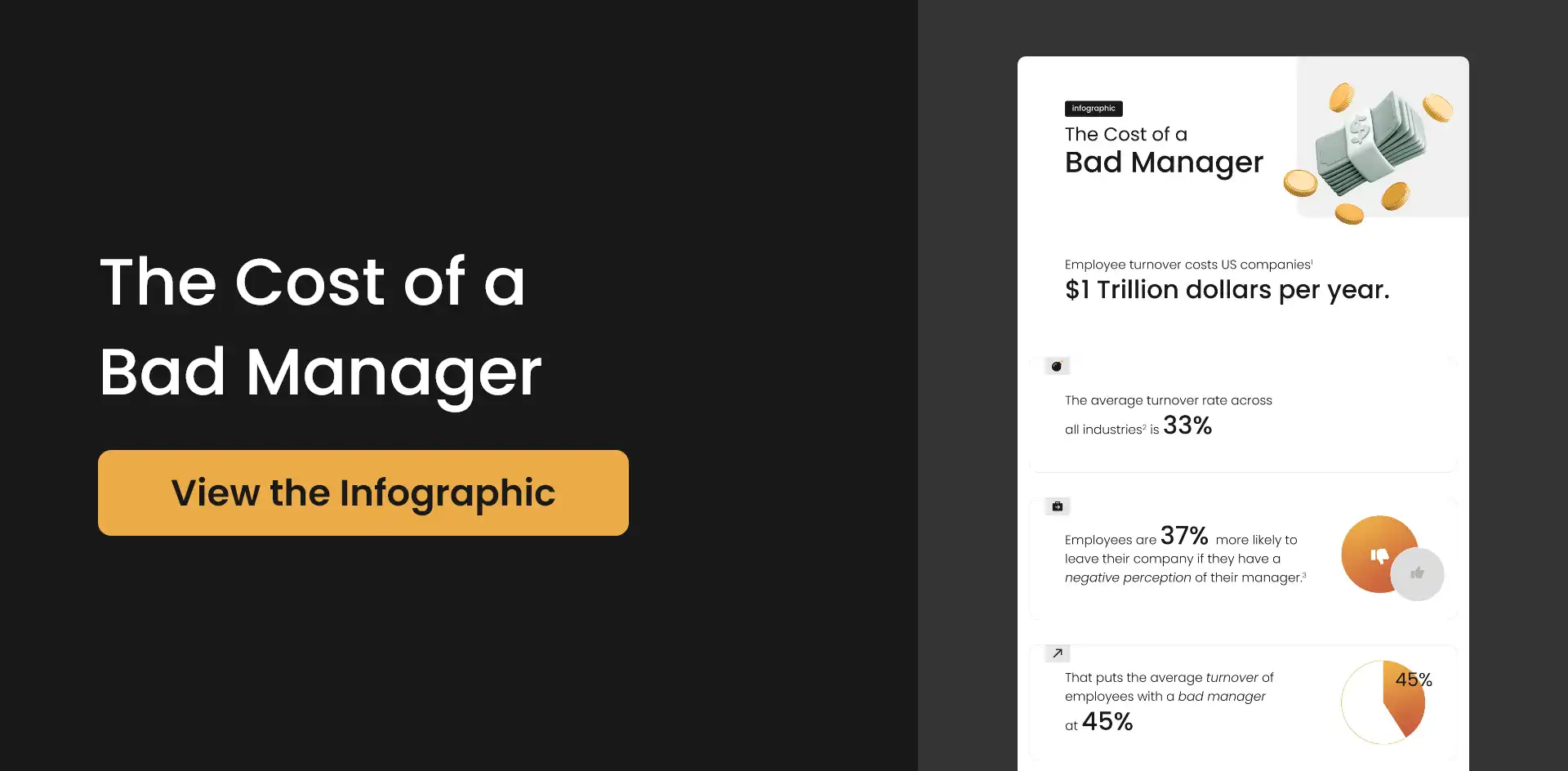Unveiling Employee Lifecycle Surveys: A Comprehensive Guide
Unlock the power of employee lifecycle surveys, surveys that measure the Employee Experience at key touchpoints throughout the year or during an employee’s career. This page provides a comprehensive guide to these types of surveys, their purpose and functionality, and how you can leverage them to improve performance and boost retention inside your organization.

Understanding your Employee Lifecycle: Key Insights and Stages
Explore the employee lifecycle – from initial awareness, to joining, and an employee’s eventual exit. Dive into the complete spectrum of events, interactions, and experiences defining an employee’s journey within your organization.
Decoding the Significance of Employee Lifecycle Surveys
Elevate your organizational insights with Employee Lifecycle Surveys, strategically gathering feedback at pivotal moments throughout an employee’s journey. From onboarding to exits and anniversaries, these surveys complement your continuous listening strategy for a comprehensive employee experience assessment.
Strategizing Employee Lifecycle Surveys for Effective Org Listening
In the competitive landscape of talent acquisition and retention, effective listening campaigns that range from employee lifecycle surveys to organization-wide surveys are crucial. Consistent feedback fosters a deeper understanding inside leaders and managers, enhancing the overall employee experience inside your organization.
Explore insights from the DecisionWise Benchmark Database. These reveals that 58% of employees feel their organizations lack effective methods for receiving and responding to suggestions. Additionally, 64% believe their opinions are undervalued. Statistics like these underscore the significance of implementing an employee listening strategy to bridge communication gaps and promote regular feedback responses.
Continuous Listening
As an organizations feedback gathering techniques evolve beyond the standard annual employee engagement surveys, HR leaders look for additional methods for gathering feedback. This can include more frequent and targeted employee sentiment assessments that are implemented during an employee’s tenure. Yet, listening campaigns cannot replace vital conversations like performance evaluations and regular one-on-ones. Instead, surveys and employee feedback enhance those key one-on-one conversations.
Crafting effective employee listening campaigns involves a blend of employee lifecycle surveys and broader surveying approaches. Tailoring lifecycle surveys to specific events, like reductions in force or new acquisitions, will enhance their utility. The key is to gather feedback from employees at critical junctures without inducing survey fatigue, ensuring a comprehensive understanding of employee experiences throughout the employee journey.
Building Strategic Listening Campaigns
Build your listening campaigns strategically by starting with the annual engagement survey as the anchor. While engagement surveys cover diverse themes broadly, organizations seeking specific enhancements can integrate pulse surveys into their campaigns. Pulse surveys, with concise10-15 question-sets, effectively target specific facets of the employee experience for focused insights.
Enhance your org-wide listening campaigns with targeted assessments. Collect valuable insights by seeking feedback on individual leaders through a 360-Degree Feedback Assessment. Evaluate recently promoted individuals or gather feedback on experiences with specific departments, optimizing your understanding of the employee lifecycle through diverse perspectives, but at a more granular level.
Optimizing Listening Strategies Using Employee Lifecycle Surveys
The most common lifecycle surveys currently used by organizations are the following:
- Exit Surveys
- New Hire Surveys
- Onboarding Surveys
- Anniversary Surveys
The first three lifecycle surveys capture pivotal moments in an employee’s journey, typically encountered only once in their employment. Insights gleaned from these assessments help drive improvements for future employees. Additionally, an annual anniversary survey serves as a recurring check on employee morale and sentiment, contributing to a continuous enhancement of the overall employee experience.
Exit Surveys
Among the standard lifecycle surveys, exit surveys take the lead as far as delivery actionable insights. Initially designed to complement exit interviews, exit surveys provide a confidential outlet for departing employees to express concerns openly. Unlike one-on-one conversations, exit surveys offer a space where departing individuals are more willing to candidly share their feedback, enriching organizations with valuable insights about employee experiences and organizational dynamics.
Components of Exit Surveys
Exit surveys generally contain three fundamental components, with the employee’s reason for leaving being the most crucial. In the DecisionWise benchmark database, the prevailing response given for leaving and organization is “growth opportunities elsewhere.” While this is a common response, exit surveys can delve deeper, uncovering a blend of reasons and causes that contribute to individuals leaving an organization. This nuanced approach ensures a comprehensive understanding beyond superficial responses and offers rich insights into employee departure dynamics.
Elevate the value of exit surveys by collecting comprehensive feedback on exiting employees’ experiences. Pose questions about managers, team relationships, day-to-day work, training, resources, communication, trust, and organizational alignment. This multifaceted approach paints a vivid picture of the overall experience of departing employees, providing nuanced insights that contribute to a clearer understanding of the organizational dynamics and areas for improvement.
Employing open-ended questions in exit surveys is an invaluable method for gathering specific feedback and gauging the general sentiment of departing employees. Additionally, leveraging organizational structure and demographic data, aids in identifying trends among diverse employee segments, contributing to a nuanced understanding of the factors influencing employee departure.
Decoding Regrettable and Non-Regrettable Attrition in Employee Lifecycle Surveys
While feedback from all departing employees is valuable, organizations can derive insights by focusing on those they genuinely hoped to retain. Analyzing exit data through the lens of regret/non-regret can help illuminate reasons for losing key employees. Designating regret (desired retention) or non-regret (acceptable departure) by managers or HR partners creates a key demographic to track. This insight aids in tailoring retention efforts for high-value employees. Additional demographics, such as job role, department, and location, further refine a leader’s understanding of perceptions and can help to inform strategic retention strategies.
New Hire and Onboarding Surveys
New hire and onboarding surveys, though often grouped, serve distinct purposes for those newer members of the organization. New hire surveys, typically conducted 15-30 days after joining, focus on the initial experience. Given this early stage, questions assessing onboarding effectiveness are premature, as most employees are still in the onboarding phase. Onboarding surveys, implemented after 90 days, assess the overall effectiveness of the onboarding process, providing insights into the employee’s longer-term integration and satisfaction within the organization.
New Hire Surveys
Utilize new hire surveys as a strategic tool to assess and ensure the needs of recently onboarded employees are met. Designed to gauge adherence to onboarding best practices, these surveys play a crucial role in confirming positive and consistent early experiences for new hires within the initial weeks of joining the organization.
A new hire survey serves as a critical tool to confirm that essential initial steps within the company are not overlooked. From meeting team members to dedicated time with managers, job-related training, and orientation on tools/resources, these surveys ensure a comprehensive onboarding experience. Whether introducing company values, mentors, or career development plans, new hire surveys validate the implementation of onboarding best practices. This timely check-in, conducted within the first few weeks, assesses the effectiveness of these activities, laying the foundation for subsequent onboarding surveys.
Onboarding Surveys in Employee Lifecycle
Onboarding Surveys, strategically sent 90 days post-hire, aim to measure the outcomes of the onboarding process. Focused on assessing new employees’ preparedness to contribute effectively, these surveys prioritize gauging readiness and willingness to perform their roles. Unlike seeking specific feedback on the onboarding process, the emphasis lies in understanding the overall preparedness and engagement levels of employees who have undergone the onboarding journey.
Onboarding Survey Components in Employee Lifecycle
There should be two primary objectives of any onboarding process.
- Enablement
- Engagement
Within the onboarding process, new employees should receive comprehensive support, including tools, resources, and training essential for effective job performance. This empowerment fosters productive contributions to organizational success; we call this process “enablement.” Facilitating the development of relationships with managers and team members, coupled with the empowerment to make informed decisions, contributes to employees feeling adequately prepared to thrive in their new roles. In the onboarding context, enablement ensures that employees, by any reasonable measure, feel ready to make meaningful contributions.
The onboarding process holds a second crucial objective – engaging new employees. Beyond merely performing their roles, new employees should find motivation and interest in their work. Designing onboarding activities with these goals in mind is essential. If the onboarding survey indicates low levels of either enablement or engagement, adjustments to the onboarding process are necessary, initiating a continuous cycle of improvement.
Anniversary Surveys
Annual anniversary surveys seamlessly integrate a continuous listening element into your strategy. As employees mark work anniversaries, they often reflect on their journey with the company. Leveraging the anniversary survey provides an opportunity to extend congratulations on this milestone while soliciting valuable feedback. The strategic advantage of utilizing anniversary dates lies in their year-round distribution. In any given month, employees across various departments and organizational levels celebrate anniversaries, creating a diverse, representative cross-section encompassing race, gender, tenure, and age. Surveying those with anniversaries each month yields a comprehensive and random sample, serving as a robust barometer for assessing overall morale within the organization.
Best Practices for Employee Lifecycle Anniversary Surveys
Streamline your anniversary surveys for optimal effectiveness. When crafting an anniversary survey, focus on essential monthly data collection. Adopting a minimalist approach works best for most organizations, typically involving a concise set of questions. In line with best practices, the DecisionWise standard anniversary survey features two key elements: an employee Net Promoter Score query and an open-ended comment prompt.
Employee Net Promoter Score (eNPS)
Elevate your company morale insights with monthly eNPS surveys. Designed to yield the most insights with just a few questions, these surveys avoid delving into intricate details of the employee experience. DecisionWise research underscores the efficacy of the eNPS (employee Net Promoter Score) as a robust gauge of overall employee morale. A standard eNPS query, such as ‘I would recommend this organization as a great place to work,’ aptly correlates with engagement metrics and retention intent.
Open-Ended Questions and Natural Language Processing in Employee Lifecycle Surveys
Enhance survey insights with open-ended questions, a valuable component in DecisionWise lifecycle surveys. In a concise assessment like the anniversary survey, neutrally worded questions play a pivotal role, encouraging detailed responses. Instead of biased queries, like ‘What did you like or dislike about your experience?’ opt for neutrally phrased ones such as “Please describe your overall experience working here.” Leveraging natural language processing, responses can be analyzed for sentiment and categorized by topics, offering a nuanced and aggregated view of employee sentiments over time. This approach provides a wealth of information for continuous improvement in your organization’s employee experience.
Exploring Additional Questions in Anniversary Surveys
Maximize insights with a streamlined anniversary survey featuring two key questions: the Employee Net Promoter Score (eNPS) and an open-ended inquiry. This approach ensures simplicity and effectiveness. Some organizations leverage the anniversary survey as a continuous pulse, integrating targeted queries on specific focus areas like cross-functional collaboration. Aligning with the annual engagement survey, these questions allow benchmarking against external standards and historical organizational data for comprehensive evaluation and improvement.
Avoid Survey Fatigue
Prevent survey fatigue by carefully managing the volume and content of survey requests. Fatigue arises when participants feel overwhelmed or disinterested due to excessive requests or lengthy questionnaires.
Prevent survey fatigue by ensuring surveys provide tangible benefits and address meaningful aspects of the employee experience. Demonstrating organizational responsiveness to past feedback enhances employees’ willingness to participate in surveys and reduces the risk of fatigue. Assess your organization’s capacity to act on survey insights to gauge the extent of your listening campaign without causing fatigue.
Recognizing indications of survey fatigue among your employees can be evident through diminishing participation rates, a crucial aspect in gauging the health of your employee lifecycle survey.
How to Get Started with Employee Lifecycle Surveys
Finding the ideal partner for your employee lifecycle survey involves aligning your organizational readiness with a tailored listening strategy. Effective listening strategies evolve incrementally. Whether your organization is already an expert in handling employee feedback or is just starting, assessing your readiness matters. If your standard feedback routine includes annual engagement surveys, now is an opportune time to broaden your approach with lifecycle surveys. For those new to this strategy, starting small by gathering manageable data for managers is a prudent step. Launching an organization-wide employee engagement survey sets the foundation. Then, integrating exit surveys allows for even deeper insights. Finally, gradually expanding with onboarding and anniversary surveys enables more frequent data collection.
More on Employee Lifecycle
Download a Sample Survey
At DecisionWise, we care about improving your understanding of the employee lifecycle within your organization. Our experts can design a custom listening strategy for you with our award-winning employee survey technology, guide you to fully understand your data insights, and help you get the results you want.





